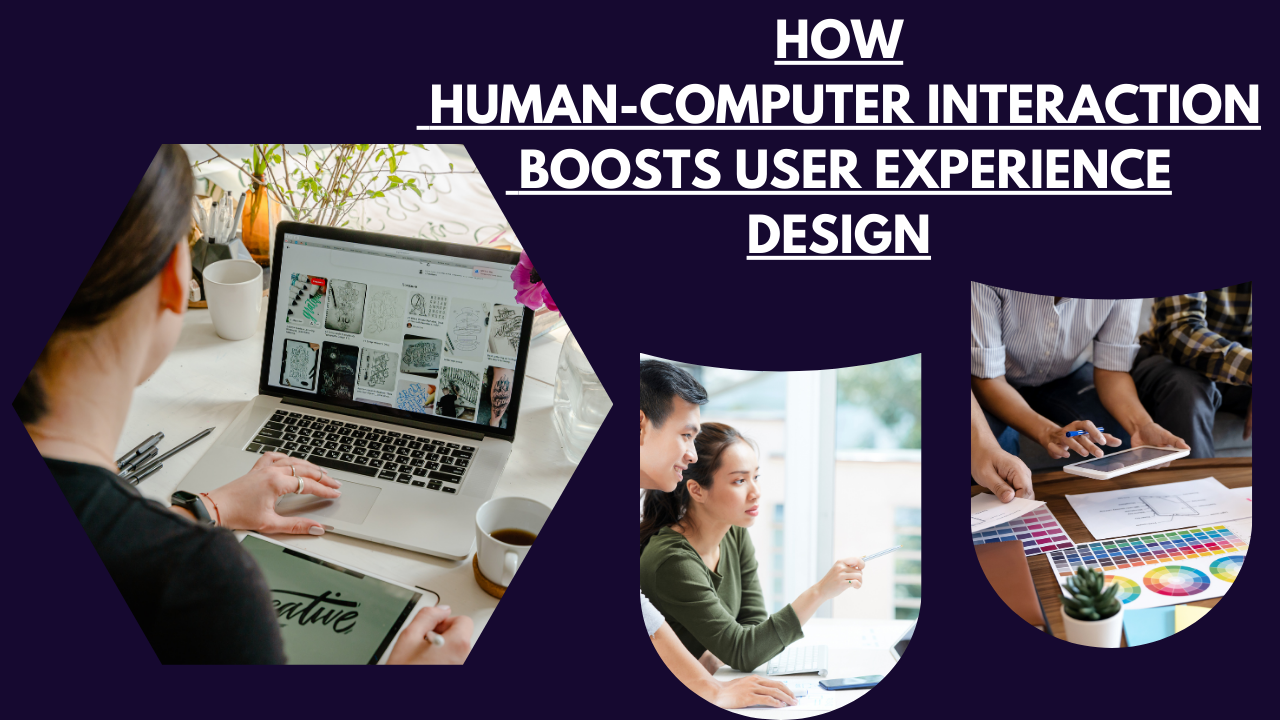Human-Computer Interaction (HCI) plays a pivotal role in shaping how users interact with technology and their experiences. As technology continues to advance, designing intuitive, efficient, and enjoyable user interfaces becomes more critical than ever. HCI is the discipline that focuses on the interaction between people and computers, ensuring that this relationship enhances usability and accessibility while aligning with user needs. Through HCI, user experience (UX) design has evolved, transforming how businesses, developers, and designers create products that are user-friendly, accessible, and adaptable to the diverse needs of individuals. This article explores how HCI is shaping and enhancing UX design in today’s digital world.
Understanding Human-Computer Interaction (HCI)
Human-Computer Interaction (HCI) is the study of how humans interact with computers and other digital technologies. This field involves designing, evaluating, and implementing interactive systems that focus on users and their needs. HCI integrates elements of computer science, psychology, design, and cognitive science to create better user interfaces. HCI ensures that the interaction between the user and the computer is as seamless as possible, fostering an intuitive and efficient relationship.
The Evolution of HCI in User Experience
HCI has transformed over the years, evolving from basic text-based interfaces to the sophisticated graphical user interfaces (GUIs) we use today. In the early stages of computing, user interfaces were designed mainly by engineers for other engineers. However, as technology became more integrated into daily life, the focus shifted toward making interactions easier for all types of users, leading to the rise of user experience design.
The goal of UX design, influenced heavily by HCI, is to make technology accessible, engaging, and useful for the end-user. UX designers rely on HCI principles to create products. They are not only functional but also offer a positive user experience. The evolution of HCI has allowed UX designers to use data-driven approaches, emphasizing user feedback and iterative design processes.
The Impact of HCI on UX Design
User-Centered Design
At the core of HCI is the user-centered design (UCD) methodology, which prioritizes the needs, preferences, and limitations of the user at every stage of the design process. UCD ensures that products are designed with the user in mind, enhancing usability and satisfaction. This has significantly impacted UX design by creating interfaces that are intuitive and easy to navigate. Instead of assuming what users need, HCI encourages designers to conduct research, usability testing, and iterative improvements based on user feedback.
Cognitive Load and Efficiency
One of the key principles of HCI is minimizing cognitive load—the amount of mental effort required to use a system. UX designers use insights from HCI research to ensure that interfaces are simple and easy to understand, reducing unnecessary complexity. When cognitive load is minimized, users can complete tasks more efficiently, leading to a smoother and more enjoyable experience.
For example, the design of mobile applications often focuses on reducing the number of steps users must take to complete an action, streamlining processes like checkout on e-commerce platforms or navigation on social media apps.
Accessibility and Inclusivity
HCI plays a vital role in promoting accessibility in UX design, ensuring that interfaces are usable by people with a wide range of abilities. By applying the principles of inclusive design, UX designers create interfaces that accommodate users with disabilities, such as visual or auditory impairments. This focus on accessibility is key to creating products that are usable by everyone, not just a specific subset of users.
Tools like screen readers, voice commands, and customizable user interfaces are examples of how HCI has pushed the boundaries of UX design to be more inclusive.
Emotional Design and User Engagement
HCI also emphasizes emotional design, which focuses on creating a positive emotional response in users when they interact with a product. Emotions play a significant role in how users perceive the functionality and usefulness of a product. A well-designed interface can evoke emotions such as trust, satisfaction, or excitement, leading to higher engagement and user retention.
UX designers use insights from HCI research to craft visually appealing, engaging interfaces. That encourages positive emotional responses, which in turn foster a stronger connection between the user and the product.
Feedback Mechanisms and Usability Testing
In HCI, feedback is an essential part of the interaction between the user and the system. Feedback mechanisms, such as visual cues, sound, or haptic feedback, allow users to understand the consequences of their actions and navigate a system more effectively. HCI has influenced UX design by ensuring that interfaces provide timely and informative feedback, reducing user frustration and improving overall usability.
Additionally, HCI promotes continuous usability testing as part of the design process. By gathering data from real users, UX designers can make informed decisions about what works and what doesn’t, leading to improved designs that align more closely with user needs.
HCI Techniques Enhancing Modern UX Design
Prototyping and Iterative Design
HCI emphasizes the importance of prototyping and iterative design. Prototyping allows designers to create mock-ups of an interface, enabling them to test and refine the design before fully developing the product. This process is essential for identifying usability issues early and making necessary adjustments.
Iterative design, which involves continuously refining a product based on user feedback, ensures that the final product is highly usable and aligned with user needs. UX designers use this HCI-driven approach to test multiple versions of a product, gathering insights that inform the final design.
Heuristic Evaluation
Heuristic evaluation is an HCI method used to identify usability problems in a user interface. It involves a group of experts who review the interface based on a set of established usability principles, or heuristics. This method helps UX designers identify potential issues early in the design process, allowing them to make improvements before the product reaches users.
By applying heuristic evaluation, UX designers can ensure that their products adhere to best practices in usability and provide a smooth, intuitive experience for users.
Personas and Scenarios
In UX design, personas and scenarios are tools used to represent different types of users. It also represents the contexts in which they use a product. HCI promotes the use of these tools to better understand user needs and create more tailored experiences. Personas are fictional characters that represent typical users. While scenarios describe specific situations in which a user might interact with a product.
By using personas and scenarios, UX designers can empathize with their users and anticipate how they might interact with the product in various contexts, leading to more effective and user-friendly designs.
The Role of Emerging Technologies in HCI and UX Design
Artificial Intelligence and Machine Learning
Artificial intelligence (AI) and machine learning are transforming HCI by enabling more personalized and adaptive user experiences. These technologies allow systems to learn from user behavior and adjust interfaces accordingly, providing tailored experiences that meet individual needs. In UX design, AI can be used to automate certain aspects of the design process. Such as creating personalized recommendations or adjusting interface layouts based on user preferences.
Voice and Gesture-Based Interfaces
Voice and gesture-based interfaces are becoming increasingly popular, offering new ways for users to interact with technology. HCI research has played a crucial role in the development of these interfaces. Which rely on natural human behaviors like speaking or gesturing. UX designers are using these insights to create more intuitive and accessible interfaces, allowing users to interact with technology more naturally and effortlessly.
Virtual and Augmented Reality
Virtual reality (VR) and augmented reality (AR) are revolutionizing HCI by creating immersive, interactive environments. These technologies provide new opportunities for UX designers to create experiences that go beyond traditional screen-based interfaces. By incorporating elements of VR and AR, designers can create more engaging and immersive experiences. That captivates users and provides new ways to interact with information.
Conclusion
Human-Computer Interaction is at the heart of modern user experience design. By focusing on the needs, behaviors, and preferences of users, HCI provides the foundation for creating intuitive, efficient, and enjoyable interfaces. From user-centered design and cognitive load reduction to emotional design and emerging technologies like AI and VR, HCI continues to drive innovation in UX design. As technology evolves, the principles of HCI will remain critical in shaping the future of user experience, ensuring that technology continues to enhance the way we interact with the digital world.
FAQs
What is Human-Computer Interaction (HCI)?
HCI is the study of how humans interact with computers and other digital technologies, focusing on designing user-friendly systems and interfaces.
How does HCI influence UX design?
HCI influences UX design by emphasizing user-centered design, reducing cognitive load, promoting accessibility, and improving emotional engagement.
What are some key HCI techniques used in UX design?
Key HCI techniques include prototyping, iterative design, heuristic evaluation, personas, and scenarios to create user-friendly interfaces.
How do emerging technologies impact HCI and UX design?
Emerging technologies like AI, VR, AR, and voice interfaces are transforming HCI by enabling more personalized, immersive, and intuitive user experiences.
Why is accessibility important in HCI and UX design?
Accessibility ensures that interfaces are usable by people of all abilities, making technology more inclusive and widely available.
